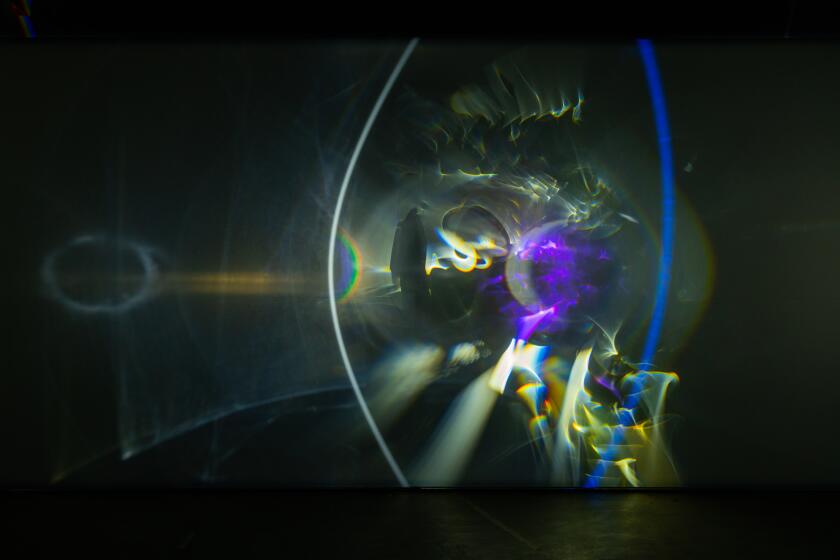‘The Cool School’
If there had been a flash grease-fire at Barney’s Beanery in West Hollywood circa 1960, the entire L.A. art scene would have been wiped out.
So deadpans artist Ken Price in “The Cool School,” filmmaker Morgan Neville’s lively, absorbing documentary about the dawn of Los Angeles’ postwar emergence as a cultural powerhouse. Price was kidding about the former artists’ hangout, but it was no joke.
Forty or 50 years ago, the American art world was a tiny sphere, just a few thousand artists, collectors, dealers and curators gathered mostly in urban centers like New York, San Francisco, Chicago and Los Angeles. Times have changed. These days that many students graduate from American art schools each spring.
“The Cool School” is a story of fitful, successful cultural ambition. It is told through fascinating film and TV footage from the mid-1950s to the late 1960s, as well as through retrospective interviews with numerous players.
Avant-garde art had been made in Los Angeles since the early 20th century -- a fact sometimes lost in the documentary’s jam-packed 60 minutes, trimmed from its already tight 86-minute theatrical release. (Co-written by Neville and journalist Kristine McKenna, it premieres nationally on PBS’ “Independent Lens” series tonight, airing locally June 19 on KCET.) There’s no overlap, for instance, between the artists in the film and those in “Birth of the Cool: California Art, Design and Culture at Midcentury,” last year’s impressive, similarly named exhibition at the Orange County Museum of Art.
But, as the movie title’s reference to a presumed “school” suggests, its narrative is less a chronicle of art than of the public genesis of an institutional art scene. An important commercial realm of contemporary art galleries erupted in the period under review, as did an influential nonprofit world of museums. The one-room “schoolhouse” was Ferus Gallery, the small La Cienega Boulevard storefront that catalyzed both sides of the institutional coin.
The first professional space in L.A. to be principally devoted to the postwar California avant-garde, the gallery introduced the work of major L.A. artists. The counterculture assemblages of Wallace Berman and the perceptual abstractions of Robert Irwin were among them. The gallery also hosted out-of-town artists, such as Andy Warhol and Frank Stella, providing competitive bicoastal energy.
Ferus has been the subject of two Southern California museum exhibitions, 1968’s “The Late Fifties at Ferus” at the Los Angeles County Museum of Art and 1976’s “The Last Time I Saw Ferus” at OCMA (then the Newport Harbor Art Museum). In New York, Gagosian Gallery mounted an impressive 2002 show, complete with a fine catalog. So Ferus’ history is well known.
But seeing it enacted and remembered on film is different. The abundant period footage, still photographs and conversations with participants add a granular texture to familiar events. More than ever, Walter Hopps is confirmed to be the historical pivot.
The late curator was born in Eagle Rock in 1932, and he died after a fall while visiting Los Angeles (from his home in Houston) in 2005. Improbably, Hopps was instrumental in establishing both curatorial sides of the institutional coin.
His 1957 collaboration in forming the gallery with artist Edward Kienholz lasted about a year, until Kienholz sold his share of Ferus to Hopps. The artist was 30 when they began, and Hopps was just 25.
The younger man had an instinct for art, but he was no businessman. Until the day Kienholz died in 1994, he reportedly maintained that his former partner still owed him $600 on the transaction. Business acumen was left to new partner Irving Blum, the smooth Knoll furniture salesman who, in the film’s wittiest montage, is repeatedly described as the art scene’s equivalent to Cary Grant.
Blum understood marketing, which made his putative discovery of Warhol, an advertising illustrator turned artist, a natural. He had a talent for making untested new art seem safe for wealthy but nervous collectors.
Neither was the mercurial Hopps an effective administrator -- a failing that caused some problems when he left Ferus in 1962 to run the funky Pasadena Art Museum. (It’s now the not-so-funky -- in fact drop-dead-lovely -- Norton Simon Museum.) At both the gallery and the museum, the art was his thing.
That is exactly what one might expect from a man whose introduction to Modern painting and sculpture came as a precocious high school student visiting the Hollywood Hills home of Walter and Louise Arensberg, America’s preeminent Dada and Surrealist art collectors. (Their collection is now a centerpiece of the Philadelphia Museum of Art.) No doubt the jazz-loving curator’s bureaucratic skills were also somewhat hampered by his fierce addiction to amphetamines.
One of the most fascinating voices in “The Cool School” belongs to Shirley Nielsen, who was married first to Hopps, then to Blum. Her description of Warhol’s debut Ferus show of Campbell’s soup can paintings -- “It was like walking into a portrait gallery” -- is disarming.
The film has several moments like that. Among them is sculptor Larry Bell’s sardonic observation that Blum’s audacious insight as a dealer in contemporary art was that “this stuff is of value” and painter Billy Al Bengston’s equally acerbic observation that “It took me several years to realize that all we [artists] were is whores and Irving is the pimp.” Blum poured a big chunk of money -- perhaps from the gallery’s unsung silent backer, Sadie Moss -- into Bell’s expensive-to-produce work; that created rifts with some among the gallery’s artists who were not similarly funded.
Barney’s Beanery is no longer an artists’ hangout. But “The Cool School” shows that the threat of a flash fire is still evident decades later.
christopher.knight @latimes.com
More to Read
The biggest entertainment stories
Get our big stories about Hollywood, film, television, music, arts, culture and more right in your inbox as soon as they publish.
You may occasionally receive promotional content from the Los Angeles Times.











